Inspired images
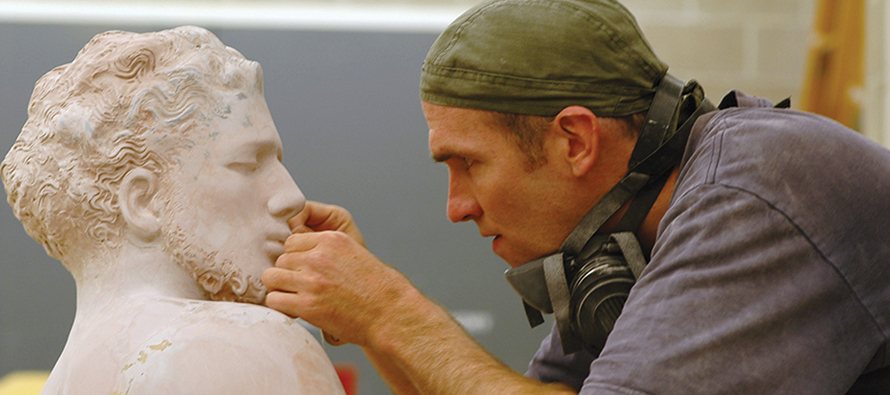
Image: BROTHER DAVID Paul Lange, O.S.B. works on the corpus for the crucifix of St. Boniface Church, Cold Spring, Minnesota.
WOULD YOU EVER THINK of art as an experience of God, or as prayer? The many sisters, brothers, and priests who are visual artists show how artistic images can reveal the divine and how creativity can be a vocation and a gift of God.
Artist and monk: A common vocation
“The monastic life and its contemplative flavor,” says Brother David Paul Lange, O.S.B. of St. John’s Abbey in Collegeville, Minnesota, “is very conducive to making art. For centuries monasteries have been the centers of artistic creativity where artisans and craftsmen have found a ready home. But there may be a tension between the two because as artists we are caught up in the appearance of things. But in monasteries we rely less on how things appear and we look beyond the surface for something deeper. It makes for creative dialog.”
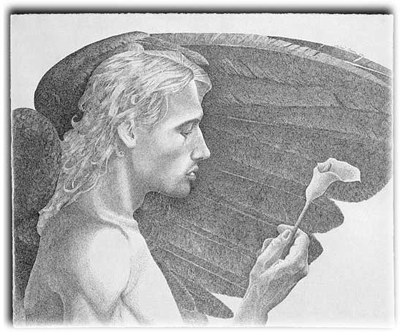 |
| ANGEL BY Brother Michael Moran, C.P. |
Work of art, work of prayer
“At this point in my life, my faith is about an encounter with or an openness to Mystery, to God,” says Passionist Brother Michael Moran, C.P. “The process of making art is prayer or meditation. Any time we experience art, and not just overtly religious art, we encounter Mystery. We’re connected to and one with something bigger than ourselves. To be able to make a painting, drawing, or linocut and provide this experience for people is very enriching.”
In addition to his art, Moran serves as chaplain of the Supportive Care Program of St. Vincent’s Hospital and conducts painting classes for senior citizens in New York City.
Windows to mystery
Sister Jeana Visel, O.S.B., a Benedictine sister of Ferdinand, Indiana, got started painting icons when a friend gave her a Christmas present of Peter Pearson’s guide to painting icons, A Brush with God. Following his directions she soon figured out the basics, and as she discovered the more spiritual dimensions of the craft she became hooked.
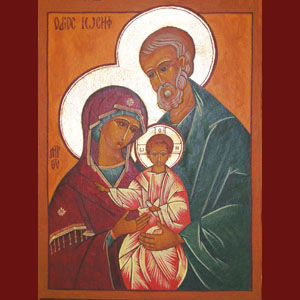 |
| THE HOLY FAMILY by Sister Jeana Visel, O.S.B. |
She also studied with Russian iconographer Xenia Pokrovsky and her assistant Marke Czarnecki to learn the traditional egg tempera technique and more about icons’ place in Eastern Orthodox Christian tradition.
“Before, during, and after the creation of the icon,” Visel says, “you pray with the person you depict and come to see how they reflect the image of God. I become a more centered, grounded person when I paint. My hope is that in praying with the art I bring to the world others also will be able to connect more completely with God. An icon should be not just religious art but a window through which we can enter the realm of mystery and grace.”
Connecting with stories
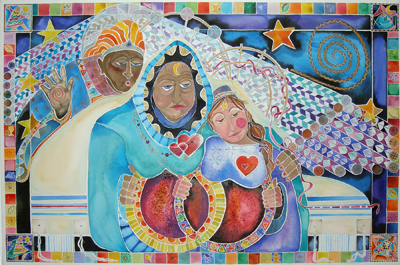 |
| THE VISITATION by Sister Nancy Raboin, P.H.J.C. |
The Sisters of the Poor Handmaids of Jesus Christ, says Sister Nancy Raboin, P.H.J.C., have always given her space to integrate creating art with her prayer, communal, and ministerial life. In response she creates art based in women’s spirituality, which, she says, “is an invitation to the viewer and myself to look at traditional scriptural stories handed down to us in both written and verbal form, such as the stories of the Annunciation and the Visitation, in a deeper way versus a static and staid way. One of the most important understandings I have gleaned from creating artwork is that it must provoke feeling.” She works in watercolor, color pencil, acrylic, pen, and ink.
Helping people see differently
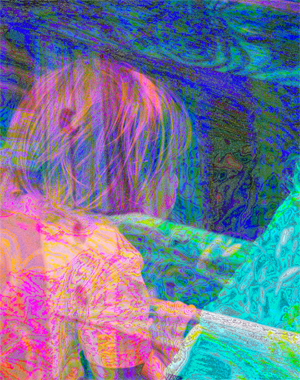 |
| SEEKER BY Sister Alma Mary Anderson, C.S.C. (Used with permission of Sisters of the Holy Cross, Inc.) |
Sister Alma Mary Anderson, C.S.C., a member of the Congregation of the Sisters of the Holy Cross, is a professor of graphic design and computer graphics at Indiana State University in Terre Haute. In addition to teaching, Anderson is a scientific illustrator for environmental health and safety textbooks. As a freelance graphic artist, she has designed books, logos, and websites.
“Much of my work, whether design or art, is created within my belief that the obligation and joy of creativity is to reach out and touch a mind, a heart, a belief, and stretch it further,” Anderson says. “A quote I have heard for years, attributed to nearly everyone, is: ‘A mind, like a rubber band, once stretched never returns to the size it was.’ It is being a stretcher and a stretchee that is the operant part of my being a religious and my being a part of the art and design fields,” she says.
The wonder of creation
With studies in both photography and theology and professional experience as a commercial and advertising photographer, Franciscan Friar of the Atonement Brother John O’Hara, S.A. brings a unique perspective to the spirituality of the photographic medium.
He says: “When I discovered my position within the spirituality of Saint Francis of Assisi, I realized that my interest in nature and the human condition reflected that of the creational approach presented by Francis. I slowly came to realize that my images were a reflection of the awe I experienced in nature and the Creator’s presence in the faces of those around me. Through my camera’s lens I was able to share with others, in some small way, the wonder I was experiencing.”
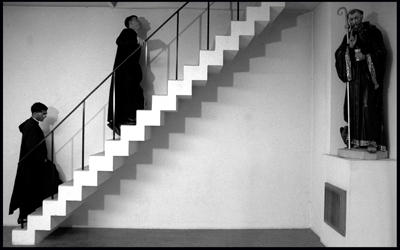 |
| BROTHER JOHN J. O’Hara, S.A.’s Jacob’s Ladder |
O’Hara facilitates workshops that “explore the expression of one’s spirituality through the photographic process” and “the idea that what one photographs is a reflection of the mind, heart, and soul” (spiritualityandphotography.org). He is also currently the director of vocations for the Atonement Friars and has worked with hospice since the mid-1980s.
A focus on mystery
“To me it seems natural that the visual arts and natural sciences flourish within, and flow from, a life of Benedictine monasticism, for I believe each contributes to the monastic vision: a vision of God present in the ordinary and the daily, and revealed in beauty,” says Sister Margaret Van Kempen, O.S.B., a sister of Saint Benedict’s Monastery in St. Joseph, Minnesota.
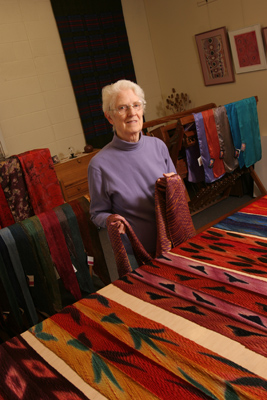 |
| SISTER MARGARET Van Kempen, O.S.B. studied shibori-making with nationally recognized fiber artists and trained in weaving with monk-artists in South Dakota and New Mexico and with a master weaver in Rhode Island. |
A retired college science teacher, she is a skilled fiber artist well known for her woven vestments and liturgical cloths and also for her arashi shibori scarves: colored works of dyed silk scarves produced by pole-wrapping silk, binding it with string, and compressing it to create tiny pleats.
“All that is mysterious and beautiful in nature is a reflection of some aspect of God’s mystery and beauty,” she says. “In a world where we are not only surrounded by God’s beauty but also by violence, one needs to focus on that which is beautiful. Doing so elevates us to the level of the eternal and gives a spiritual meaning to our lives.” See more of her work.
In love with creation
Friar Vincent Petersen, O.F.M. Conv. is a member of the Conventual Franciscan’s Our Lady of Consolation Province in New Mexico. Originally from rural Minnesota, he became “enchanted with the colors and the drama of the Southwest,” he says. He has a bachelor of arts degree in studio arts from St. Louis University and a master of divinity degree from Washington Theological Union. He lives with five other friars at Holy Cross Retreats in Las Cruces, New Mexico and is pastor of Our Lady of Guadalupe parish.
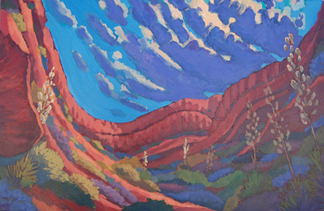 |
| HIDDEN PRAYER by Friar Vincent Petersen, O.F.M. Conv. |
“As part of my mission as a Franciscan,” he says, “I want to teach people how to see. That is, I want them to fall in love again with the divine image that is hidden within all of creation. Every painting is an icon of God. The earth is the primary revelation of God. To understand this is to begin to save the planet.”
Dominicans then and now
In Sister Thoma Swanson, O.P.’s watercolor The Dominican Family Under Mary’s Mantle, Mary holds open her mantle at the request of Saint Dominic, who has been looking all over heaven for his brothers and sisters.
He finds that Mary is sheltering members of the whole Dominican family, such as Catherine of Siena, Pope Pius V, Thomas Aquinas and his mentor Albert the Great, Fra Angelico, and the Peruvians Rose of Lima and Martin de Porres as well as contemporary Dominicans—an Asian sister, an African friar, and a sister graduate with her diploma symbolizing the continuing dedication of Dominicans to study and learning.
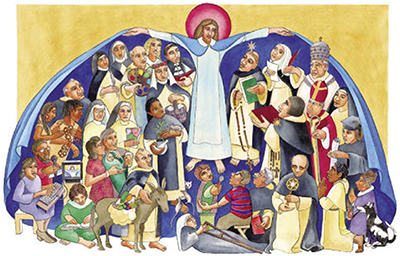 |
| GiICLÉES—high-resolution ink-jet prints— of Sister Thoma Swanson, O.P.’s The Dominican Family Under Mary’s Mantle have traveled around the world to various Dominican communities. |
“Creativity is God’s personal gift to an individual,” Swanson says. “Each artist is unique and each is able to reflect through her art a different facet of God’s immensity. Creativity surely marks out the path of the artist to God.”
“God Doesn’t Like Ugly”
Father Frank Sabatté, C.S.P. first encountered the Paulists while studying art at U.C.L.A., where he earned a B.A. in studio arts (he also has an M.A. in sacred theology from the Catholic University of America). “My passion for art came out of my experience at U.C.L.A.,” he says. “I was drawn to the Paulists because they truly respect the gifts of the individual. I felt that I was part of the church, and that the church needed me. I liked the whole idea of building church.”
He has also developed an outreach to artists in New York City. This ministry, called Openings (openingsny.com), is “run for the artists by the artists,” Sabatté says. It provides a forum where young artists can become “more aware of the spiritual mystery they are already involved in. Artists are hard-wired to connect with the transcendent whether they know it or not. . . . We’re not out to convert people. What we’re trying to get people to understand is that they are already involved in the mystery. It’s really about them teaching us.”
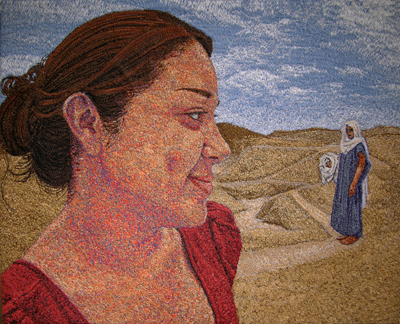 |
| RUTH; random stitch free-motion embroidery by Father Frank Sabatté, C.S.P. |
Each year Openings stages an exhibition at the Church of St. Paul the Apostle in Manhattan. Themes for the shows have included “Freedom and Beauty: The Art of Iraqi Refugees,” “Who, What, Where, When, Why Is God,” and “God Doesn’t Like Ugly.”
Sabatté (www.sabatte-arts.com/) works in painting, sculpture, and random stitch free-motion embroidery, a type of machine-stitching that allows the artist to move around the fabric in any direction, creating geometric, flowing, or random patterns.
The power of icons
“As a college woman in Kirkwood, Missouri, I was kneeling in front of an icon when I felt drawn to give my life to God as an I.H.M. sister,” says Immaculate Heart of Mary Sister Nancy Lee Smith. “The image was of the Mother of Perpetual Help. . . . Ever since that moment the compelling power of icons has spoken to my heart, never quite leaving me.”
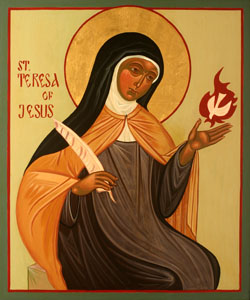 |
| SISTER NANCY Lee Smith, I.H.M.'s Saint Teresa of Avila |
Smith’s studies include a degree in fine arts, and she has taught and worked as a chaplain and in retreat and parish ministry. Much later she had an opportunity to immerse herself in icon writing, apprenticing with a master from Moscow. She produces her commissions of both icons and other types of paintings at Saint Joseph Studio (SaintJosephStudio.com) on her community’s motherhouse campus.
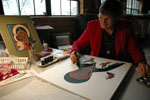 |
| SISTER NANCY Lee Smith, I.H.M. |
“Life journeys start with early graces that we seldom understand at the time,” she says. “It’s only in looking back that we begin to see threads of love drawing us all along.”
God as beauty
Sister Maria Marcela Machicote, S.N.D., a native of Buenos Aires, Argentina, is a temporary professed member of the Sisters of Notre Dame of Chardon, Ohio. As a child she came to love nature as a way of being close to God. This love led her to become a scientist, focusing on wildlife ecology.
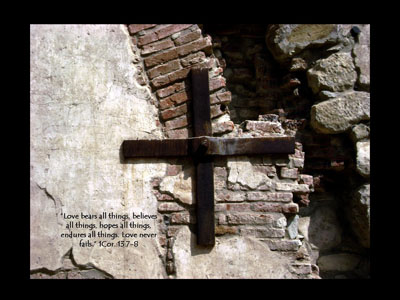 |
| PHOTOGRAPH BY Sister Maria Marcela Machicote, S.N.D. |
Sensing a desire for something more, Machicote entered the Sisters of Notre Dame in the fall of 2005. With the help of a camera and a computer she reconnected during her novitiate with her early experience of God “as beauty, as awe, as grandeur.” Religious life, she says, gave her time and space to explore “new ways of sharing the beauty and awe of God so that others may come to experience it as well.”
Writing the holy
Brother Michael Marcotte, O.S.B., a Benedictine monk of Conception Abbey in Conception, Missouri, has been a calligrapher for nearly 40 years and is currently art director of the abbey’s Printery House Christian greeting cards publishing and distribution house.
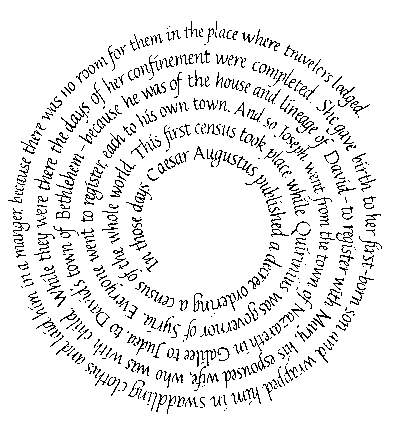 |
| CALLIGRAPHY DESIGN by Brother Michael Marcotte, O.S.B. |
“Calligraphy touches upon the very fabric of monastic life,” Marcotte says. “Early monks copied manuscripts in order to have books available to each monk to read during the periods of the day that Saint Benedict prescribed for sacred reading. This lectio divina, or slow rumination on the scriptures, is at the core of the monastic life—a type of study which gradually transforms the monk into that which he reads. For me, it is when I copy the scriptures that art is most at the service of my monastic vocation. Calligraphy affords a slow pondering of the word, stroke by stroke, letter by letter, word by word. It involves yet another of the senses—that of touch, a physical involvement with scripture.”
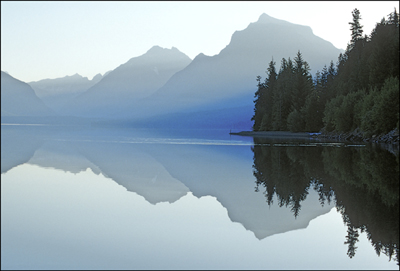 |
| BROTHER JOHN Lemker, S.M.’s Mountain Reflections |
The spirit of nature
Aware of the role of the beauty of nature in contemplation and nurturing the spirit, Marianist Brother John Lemker, S.M. has been a nature photographer for the past 25 years. His images have been published nationally and internationally and are in private collections.
A ministry in murals
“Creating ceramic murals for churches, schools, hospitals, and libraries has become a real ministry for me,” says Sister Jane Mary Sorosiak, O.S.F., a Sister of St. Francis of the Congregation of Our Lady of Lourdes in Sylvania, Ohio. “I believe that art appeals to the spiritual in each of us and should be uplifting. My vocation to religious life has afforded me the opportunity to use my talents in this direction.”
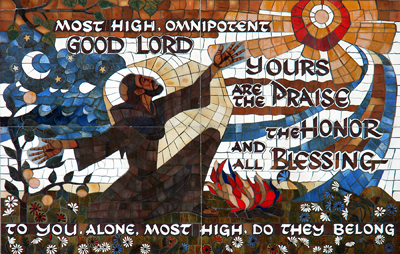 |
| SAINT FRANCIS Praising Creation, a mosaic at the Sylvania Franciscan motherhouse, is a 24-by-18-foot ceramic mural Sister Jane Mary Sorosiak, O.S.F. created in her studio and assembled on the building in 1980 |
After she formulates an idea, Sorosiak makes several small sketches before drawing the full-sized mural on tracing paper. She then rolls out a slab of clay and traces the design onto it, cuts the individual pieces, numbers them, and heats them in a low-fired kiln at 1,500 to 1,800 degrees. After the pieces dry they are glazed and high-fired in a kiln at 2,300 degrees. She then cements the pieces in place and adds grout.
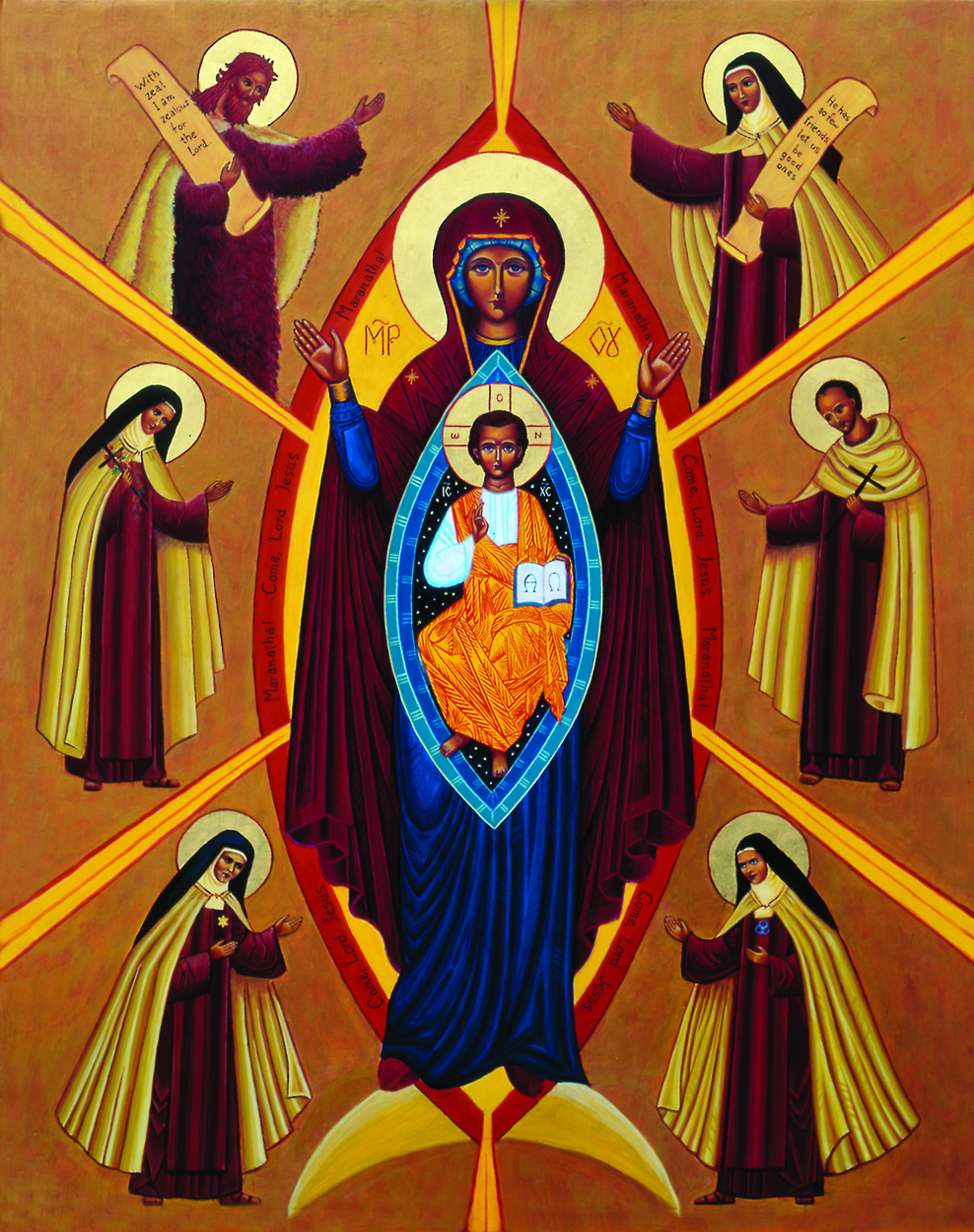 |
| COME, LOED Jesus by Sister Mary Grace, O.C.D. |
Revealing the truth and beauty of God
There is a radiance surrounding truth, and this radiance is a sign that truth has an impulse to expand in all directions. The radiance surrounding truth is beauty. In this way, truth is able to penetrate far and wide. The radiance of beauty prepares the way for truth.
“This quote from [philosopher] Max Picard, which hangs in my studio,” says Sister Mary Grace, O.C.D., a Discalced Carmelite Nun of the Carmel of Terre Haute in western Indiana, “sums up the rationale for all my work in writing icons. Everything I do in this holy discipline is for the purpose of proclaiming the truth of Jesus Christ and attracting people to him.
“Icons give no leeway for artistic license in the ordinary sense, even though each icon inevitably bears the stamp of the one by whose hand it was ‘written,’ ” she says. “Hopefully, if the artist is a person of spiritual depth, then she is able to disappear even more, letting the holiness of the Lord and his saints shine through in the icon unhindered. This is my ambition. I want to write icons that are ‘mercilessly beautiful’ for the sake of attracting every heart to the truth and the unsurpassed beauty of the Lord.”
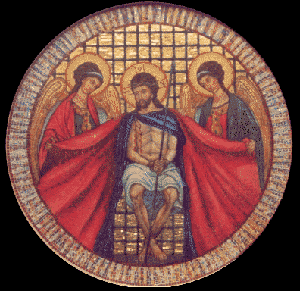 |
| FATHER RICHARD Cannuli, O.S.A.’s Christ the Bridegroom mosaic |
Knowing the Creator
Father Richard Canulli, O.S.A. (www.richardcannuli.org), an Augustinian priest and professor of studio arts at Villanova University in Villanova, Pennsylvania, has designed stained glass and more than 1,000 liturgical vestments. He has also created watercolors, prints, and icons—two of which, Do Not Weep for Me, Mother and Not Made by Hands, are in the collections, respectively, of Cardinal Mar Nasrallah Peter Sfeir, the patriarch of the Maronite Catholic Church, and of St. Catherine’s Monastery, Sinai, Egypt. Throughout his studies he has also worked in metals, ceramics, oil painting, acrylic painting, and sculpture and is a certified liturgical design consultant.
“Creative expression is a process in which one touches spirituality continually, for in creativity we begin to know the Creator,” he says. “As we share the beauty and manifestation of new ideas and forms we explore the potential of ourselves and see the greater self. Art is not a metaphor for creation; it is the continuation of its presence. I most fervently want to impart the spirit of joyous union that comes from the concentration on this spiritual and beautiful journey.”
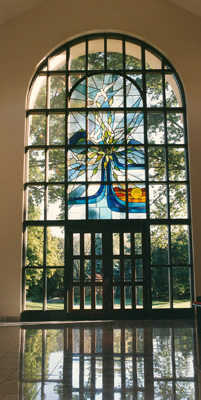 |
| RIVER OF PEACE window by Sister Emmanuel Pieper, O.S.B., St. Walburg Monastery, Covington, Kentucky |
Illuminating places of faith
Sister Emmanuel Pieper, O.S.B. entered St. Walburg Monastery in Covington, Kentucky at the age of 17 and has been a professed Benedictine sister for 63 years. She earned a master of fine arts degree and says of her work: “I delight in the opportunity to work for the church, to illuminate the faith. . . . My greatest joy is to see my work in places of worship where people find it uplifting and enriching of their spiritual life.”
Looking deeper
Sister Catherine Salani, D.C., a member of the Daughters of Charity of St. Vincent De Paul, has taught, coached, and served as a campus minister at St. John’s University, Queens, New York as well as ministered at the St. John’s Bread and Life Soup Kitchen in Brooklyn, where she provided a blend of art and spirituality for the HIV and mothers’ support groups.
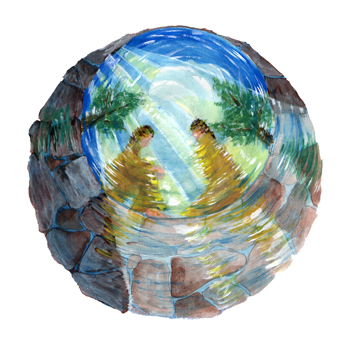 |
| SISTER CATHERINE Salani, D.C.’s Woman at the Well from the Well’s Perspective |
Salani believes that “art and spirituality are one and the same. Drawing and painting are a form of prayer as much as meditation and gospel sharing. Scripture and nature are two sources where possibilities are teased out and inspiration drawn. It’s a way of experiencing God the Creator that feels most alive and most centered.”
She has worked in pen and ink, colored pencil, pastel, and acrylic paint and in realistic, abstract, and graphic design styles. “There are so many layers to visual art, you can always go deeper,” she says.
Tags
Related
- Religious communities have deep and diverse roots
- Scientific wonder is God’s handiwork
- Respite and renewal brought to you by religious communities
- Lives that lead to God: Biographies and memoirs
- Religious orders aid and advocate for migrants
- Rural religious take to the highways and byways
- Divine design: The holiness of place
- More prayer spaces of religious communities
- Word as witness to the Word
- More poems by religious Read More
Most Viewed
- Find your spirituality type quiz
- FAQs: Frequently asked questions about vocations
- Celibacy quiz: Can you live a celibate life?
- Resources for older discerners or those with physical and developmental differences
- About Vocation Network and VISION Guide

